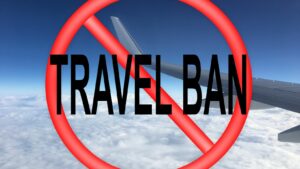As the world grapples with the fast-paced changes brought on by the COVID-19 pandemic, travel has become a complex affair. In the heart of these changes, New York State’s travel ban has emerged as a hot topic. With its implications for residents, visitors, and businesses alike, understanding the ban is crucial.
Stay tuned as we delve into the specifics of the ban, its exceptions, and what it means for you. With a clear understanding, you’ll be better prepared to adapt your plans and make informed decisions about your travels.
NYS Travel Ban
 Diving deeper into understanding the New York State (NYS) travel ban reveals its multifaceted nature. It, born due to the unprecedented outbreak of the COVID-19 pandemic, has significant implications for residents, tourists, and businesses alike; with its essence rooted in safeguarding the welfare of the public.
Diving deeper into understanding the New York State (NYS) travel ban reveals its multifaceted nature. It, born due to the unprecedented outbreak of the COVID-19 pandemic, has significant implications for residents, tourists, and businesses alike; with its essence rooted in safeguarding the welfare of the public.
It seems inevitable, in a pandemic-influenced world, that public health becomes the paramount concern. The primary reason for the NYS travel ban revolves around this very concern, preventing the further spread of the COVID-19 virus. Consequently, a ban on non-essential travel emerged as a potent tool to arrest the spiraling numbers of infected individuals.
The Legal Framework
Central to the NYS travel ban is a robust legal framework, laid out to ensure compliance. The public health law of New York issues certain directives to establish the ban’s efficacy. Travelers violating the ban could face penalties, highlighting the government’s decisive stance against non-adherence. For instance, those who do not submit a traveler health form upon entry into New York, a requirement as per the ban, may be subjected to a fine.
Impact of the NYS Travel Ban
Within the ambit of the NYS Travel ban, its faction extends to numerous stakeholders. Two groups significantly impacted include the tourism industry and local businesses. A definitive exploration elucidates the sweeping impact of this regulation.
Effects on Tourism Industry
In light of the ban, the tourism industry experiences drastic implications. A plummeting number of tourists, for instance, characterizes this sector. Due to travel restrictions, New York’s major tourist attractions, like the Statue of Liberty and Times Square, report shrinking footfall — a significant marker of the industry’s decline.
Consequences for Local Businesses
The ripple effect of the NYS travel ban extends to local businesses as well. Reduced tourist footfall consequentially affects businesses that depend heavily on tourist spending – such as souvenir shops, local eateries, and guided tour services.
Moreover, businesses engaging in imports or exports face challenges due to the ban’s disruption of global supply chains.
NYS Travel Ban Exceptions and Exemptions
Who Qualifies for Exemption?
A diverse range of individuals may qualify for exemptions under the New York State travel ban. They include, but aren’t limited to, essential workers, first responders, healthcare providers, and certain government officials. For instance, health workers tackling the health crisis directly might not come under the travel restrictions.
How to Apply for an Exception
Applying for an exception entails following a specific procedure. Firstly, individuals must consult the official New York State Department of Health website. They can access the relevant forms there and fill out the requested information. This includes details such as their occupation, reason for exemption, and duration of stay. Subsequently, they submit the form online.
Compliance and Enforcement
Role of Law Enforcement Agencies
 Law Enforcement Agencies have a central role in policing the travel ban. They have the mandate to scrutinize incoming travelers, verifying essential versus non-essential travelers at points of entry, be it airports, borders, or harbors.
Law Enforcement Agencies have a central role in policing the travel ban. They have the mandate to scrutinize incoming travelers, verifying essential versus non-essential travelers at points of entry, be it airports, borders, or harbors.
Tasked with ensuring visitors’ compliance with the NYS travel ban, these agencies are adept at enforcing quarantine regulations.
Infractions of the travel ban attract significant penalties as a deterrent. Fines, as one of the punitive measures, are categorized into various tiers. A first-time violation of the quarantine order may attract a fine up to $10,000, while causing harm due to non-compliance might lead to a penalty up to $25,000.
Must Know
Navigating the NYS travel ban is a dynamic process that requires staying informed, understanding quarantine requirements, and recognizing the necessity of travel. It’s a fluid situation, influenced by the evolving Covid-19 crisis, and could see modifications from easing restrictions to implementing stricter measures.
